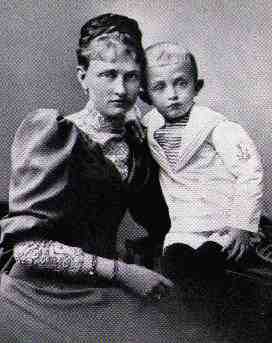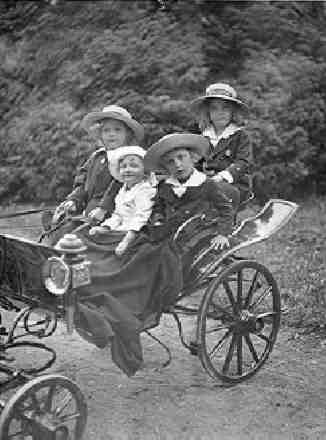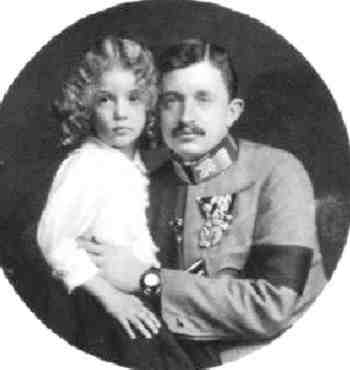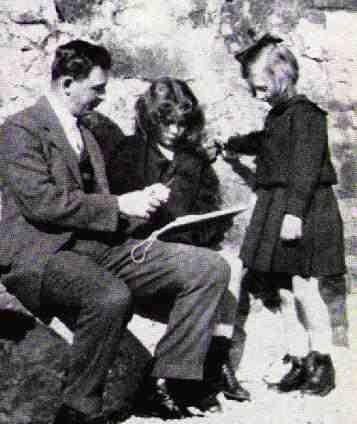
Austrian Royalty: Karl I (1916-18)

Figure 1.--Sailor suits were popular among royalty all over Europe, even in countries like Austria-Hingary with small navies. This picture was taken about 1881 and shows Karl, the future Charles I--the last Emperor of the Austian-Hungarian Empire. Note the striped dicky which is characterictic of Austrian sailor suits.
|
|
Charles I or Karl I (Charles IV of Hungary) (1887-1922) was another of Francis Joseph's nephews (figure 1). He was only sixth in line to inherit the throne, but the more senior family members invalidated their claims by marrying commoners or were not suitable. Karl served in the Army, but favored a negotiated end to the War. He was to be the last Habsburg ruller of Austria.
Parents
Karl's father was Otto Habsburg-Lotharingen (1865- ). Otto's parents were Archduke Karl Ludwig Habsburg-Lotharingen (1833- ) and Annunciata de Bourbon of Sicily (1843- ). Karl's mother was Maria Josepha Wettin of Saxony (1867- ). Her parents were King George Wettimn of Saxony (1832- ) and Maria Anna of Saxe-Coburg-Gotha (1843- ).
Siblings
Karl had a brother Archduke Maximilian Eugene Habsburg-Lothringen (1895-1952. He had one child Child 1: Archduke Ferdinand (1918- ).).
Childhood
I have no information on Karl's boyhood. Karl was born August 17, 1887, at Castle of Persenbeug which is located in Lower Austria. As the great-nephew of Emperor Franz Joseph, no one really thought that one day he would become emperor. There was no reason to believe he would become Emperor as there were so many cousins ahead of him dynastically.
Childhood Clothes
I have few details about how Charles was dressed as a boy. He seems to have passed out of dresses by about 4 years of age as he is pictured in a sailor suit with knee pants rather than a skirt in a photograph taken with his mother about 1891.
Hair Styles
I do not know what hair styles Karl wore as a very young boy. At about 5 or 6 after breeching he wore very short cropped hair. This is in sharp contrast to the long hair that his sons wore ast the same age.

Figure 2.--This is the Austrian royal family. The caption reads, "Die Kinder des Kaiserpaares auf ihren Speilplatz." This means, "The children of the imperial couple at their playground". The photograph is undated, but was probably taken in 1916 or 17.
|
|
Education
We do not have details on Karl's education at this time. I assume he attended a military academy. We do know that religion was an important part of his upbringing. The Hapsburg family since the medieval era and especially the Reformatuin had been a major support for the papacy and the Catholic Church in Germany and Europe. By all accounts Karl had a deep Catholic faith.
Marriage (1911)
Karl married Princess Zita of Bourbon-Parma in 1911, only 3 years before the World War I. The Princess shared Karl's deep religious convictions.
Karl married Princess Zita von Bourbon-Parma of Parma Her parents were Duke of Bourbon-Parma (1848- ) and Maria Antonia de Bragança of Portugal (1862- ). I know little about Princess Zita at this time. We know that she was involved in children's charities. She agree with her husband that the War had to be resolved with a negotiated settlement. They hoped to use her brother, Prince Sixtus of Bourbon-Parma as an intermediary.
World War I (1914-18)
World War I followed from Austria-Hungary's decession to punish Serbia for the assasination of Archduke Franz Ferdinand. After the death of Archduke Ferdinand, Austria invaded Serbia. The Russians mobilized to help Serbia. The Germans mobilized first and invaded France which was allied with Russia. The British entered the War when the German attack on France was directed through neutral Belgium. The Austrian military did not perform well and they had to seek German assistance. The War proved a disaster for Austria-Hungary and the Hapsburg monarchy.
War Service (1914-16)
Karl at the beginning of the War commanded an Austrian Army in Romania. Romania joined the Allies, but was defeated by Austrian and German forces. When Emperor Francis Joseph died (1916), Karl returned to Vienna to rule.

Figure 3.--The Emperor Karl is pictured here with his son Otto. Note Otto's curls. The Emperor is wearing a mourning band, presumably for Emperor Franz Josef. This suggests the portrait was taken in 1916.
|
|
Karl I was the last of the Hapsburg rulers. Although he was the eldest son of the Archduke Otto, he was little known in Europe until he married Princess Zita. Karl replaced Francis Joseph when the Emperor died (1916). Karl became Emperor of Austria during the terrible tragedy of World War I. Karl's efforts at diplomacy to end the War allienated his German allies. He favored the French claim, for example to Alsace-Loraine. He orcestatrated peace-feelers to the Allies. Of course the Allies focus was on the Western front and Emperor Karl could not offer the Allies what they most wanted, occupied France, Alsace-Loraine, and Belgium. Thus peace feelers from Austria without German supportt had little real chance of ending the War.
Republic Declared (1918)
The Austrian monarcy like many of the European crowns were casualties of the War they had led their people into. Assigning blame is difficult. Cetainly the Emperor Franz Joseph and Kaiser Wihelm II played key roles, but the Tsar , Republican France, and the British as well as othert regimes have to assume some responsibility. The Empire and the monarchy crumbled after the War. After the military collapse of Austria-Hungary in 1918, several independent governments emerged. Polish areas joined the new Polisdh state. Czechoslovakia energed from Bohemia and Slovak areas. The Hungarians formed Hungaria. Bosnia and Croatia and other areas were fused with Serbia to form Yugoslavia. Emperor Karl still hoped for a Austria monarchy. Karl Renner, leader of the Austrian Social Democrats, demanded a republic. Many Austrians wanted an Anchluss with Germany. German royal families as the situation on the Western Front deteriorated, abdicated as republican forces seized control. Emperor Kasrl rejected abdication. He saw his imperoiasl title as a mandate from God. On the same day the Armistice in the Western Front went into effect (November 11), Karl agreed to withdraw from active government and accept the choice of the Austrian people in a plebiscite. He issued a similar declaration for Hungary (November 13.) It is unclear how the Austrian people would have voted. It is quite possible they would have approved a monarchy. Conditions in Vienna, however, were chaotic with threatening Communist mobs. Renner engineered a vote in the Austrian caucus of the Imperial Parliament. The caucus approved Renner’s “Law Defining the Form of State” (November 12). The law proclaomed a republic and Article Two proclaimed that Austria was "an integral part of Germany.” Later this was to be undone by the Peace Treaty of St. Germain-en-Laye.

Figure 4.--This photograph of Adelherd and Otto shows how they were usually dressed in similar outfits, in this case sailor suits. The photograph was taken in 1919 or 1920. I'm not sure who the man is. It looks like it might be their father.
|
|
Kasrl and Zita had eight children, the eldest were two boys (Otto and Robert) and a girl (Adelheid) (figure 3). The eldest was Prince Otto (named after his grandfather) who was born in 1912. Grand Duchness Adelheid was born a year later in 1913, and Robert the second son was born in 1915. Charles and Zita's children came about one a year.
The royal family raised their eight children in a deeply religious Catholic environment. The family had to deal with war, revolution, and exile which would fundamentlly change the Hapsburg family and Austria itself. Religion was an important part of the royal family's life. Karl and Zita held family devotions, including the Rosary, novenas, and Scripture readings. There were family catechism lessons, daily Mass, and various pious practices that had been developed by the Habsburg family over its long history. These included Pietas Austriaca (devotion to the Blessed Sacrament, the Holy Cross, the Immaculate Conception, and Corpus Christi). It was a close family with the Emperor and Empress deeply devoted to their children. The photographic record provide some tendender images of the parents with their children and of the children playing hapily together.
Otto was to be the heir to the Hapburg throne. His full name was Franz Josef Otto. The children were very smartly dressed in many formal and informal photographs. Otto is pictured in a variety of outfits. As a small boy he wore dresses. A family portrait taken when he was about 3 years old shows him wearing a dress. He also wore a dress for the emperor's funeral in 1916 when he was about 4 years old. Otto was never able, however, to rise to the throne. The Austrian monarchy disappeared in the aftermath of World War I.
Emperess Zita liked to dress the children in coordinated or identical outfit. As babies the children wore white dressess. There seem to have been starndard outfits for the boys and standard outfits for the girls. Zita seems to have based the standard boy's oiutfit on the clothes worn by the oldest boy--Otto. When he had his hair cut and began wearing sailor suits, so did the younger boys. We see Otto, the oldest child wearing a broad-brimmed hat with down turnd brim with a tunic jacket and straight-leg shorts. As best we can tell he wears short pants and not knee pants. We also see him wearing a regular broad-brimmed hat. A few years later all the boys are wearing frilly white blouses and short pants. We also see them wearing what look like t-shirts and white short pants Later when the boys are a little older they wear sailor suits with long pants. The children commonly wore strap shoes, both dark and white as well as high-toped shoes.
Emperess Zita believed in lon hair styles for her children, especially the boys. This as especially the case for Crown Prince Otto. He wore his hair long for severl year after breaching, even apparently as a young teenager. His mother nev curled his hair, but it was left quite long. Otto in many photographs hs longer haot than his sisters. It was quite common in the early 20th century for mother who kept their son's hair long to style the hair of sons and daughters differently. It was, however, not that common to have longer styles for boys than girls. The image here is a good example (figure 4).
When the Austrian Parliament declared a republic (November 12), Karl, Empress Zita, and the children were forced to flee Vienna. Coditions there were chaotic and Communist mobs a threat. Karl once away from Vienna and immediate danger, Karl issued a Manifesto and Diplomatic Protest at Feldkirch (March 24, 1919). He took issue with the Renner government’s failure to hold a plebiscite and proposed Anschluss with Germany. While they had managed to escape, the royal family were virtually destitute.Their Austrian property and funds were confiscated by the new Austrian state. Zita was pregnant with Rudolph. When he was born, Zita had to find a donated laundry basket for a crib. Karl took his family to Switzerland. After the tumultous War and post-War years, the time in Swizerland were placid. Karl was left, however, woth very little money.
Hungary (1921)
Karl attempted to regain the Hungarian throne twice in 1921. Hungary continued de jure as a monarchy kingdom and had not declared a republic. Admiral Nicholas Horthy served as Regent for Karl who continued as the titular monarch. Karl covertly returned to Hungary during Holy Week, 1921. Horthy had personally sworn an oath to restore Karl. Karl's plan was take advantage of the holiday and present the country with a fait accompli. Admiral Horthy did not, however, fulfill his obligations. He did not support Karl and expelled him from Hungary. I'm not sure why Horthy broke his oath. Apparently Horthy had gotten used to the perogatives of power.
Karl thought that there was support for him within the army which included many officers from the old imperial army. He and Zita flew in an open plane from Switzerland to the Hungarian estate of a supporter. A company of troops lcommanded by Col. Anton Lehar (brother of the composer Franz). They commandeered a train and moved toward Budapest. A truce was arranged with Horthy. Horthy ordered troops to seize the train. They arrested Karl and Zita who were confined at the Monastery of Tihany on Lake Balator.
Madeira (1921-22)
Admiral Horthy was unsure what to do with Karl. A Council of Allied and Successor States Ambassadors was organized to decide his fate. Zita was again pregnant. The Allies had wanted to try Kaiser Wilhelm who sought refuge in the Netherlands. The Dutch refused, however, to turn him over. Now they had another of the Central Powers leaders under their control.
Some wanted him found guilty of war crimes and imprisoned. He was not, however, seen as culpable in the same sence as Kaiser Wilhemp or Emperor Franz Josef. Thus a Napoleon-like solution to the “Habsburg problem” was decided upon by the ambassadors. He was exiled to Madeira and the British Royal Navy deposited him there (November 19, 1921). He was destitute. A local banker provided him a home up in the mountains. Maderira is a rainy island and the climate was not good for Karl's already weak health. The children joined them there. Karl caught a cold which developed into pneumonia (March 1922). Zita was again pregnant when Karl died. It has been aledged that Maderia was specifically selected because Karl had weak lungs and the wet climate was not healthful climate for him. I do not know specifically why Maderia was chosen.
HBRC

Navigate the Boys' Historical Clothing Web Site royal pages:
[Return to the Main Austria pages]
[Return to the Main royal pages]
[Belgium]
[France]
[Germany]
[German states]
[Italy]
[Monaco]
[Netherlands]
[Norway]
[Romania]
[Russia]
[Spain]
[United Kingdom]
Created: February 26, 1999
Last updated: 5:14 AM 3/9/2011







